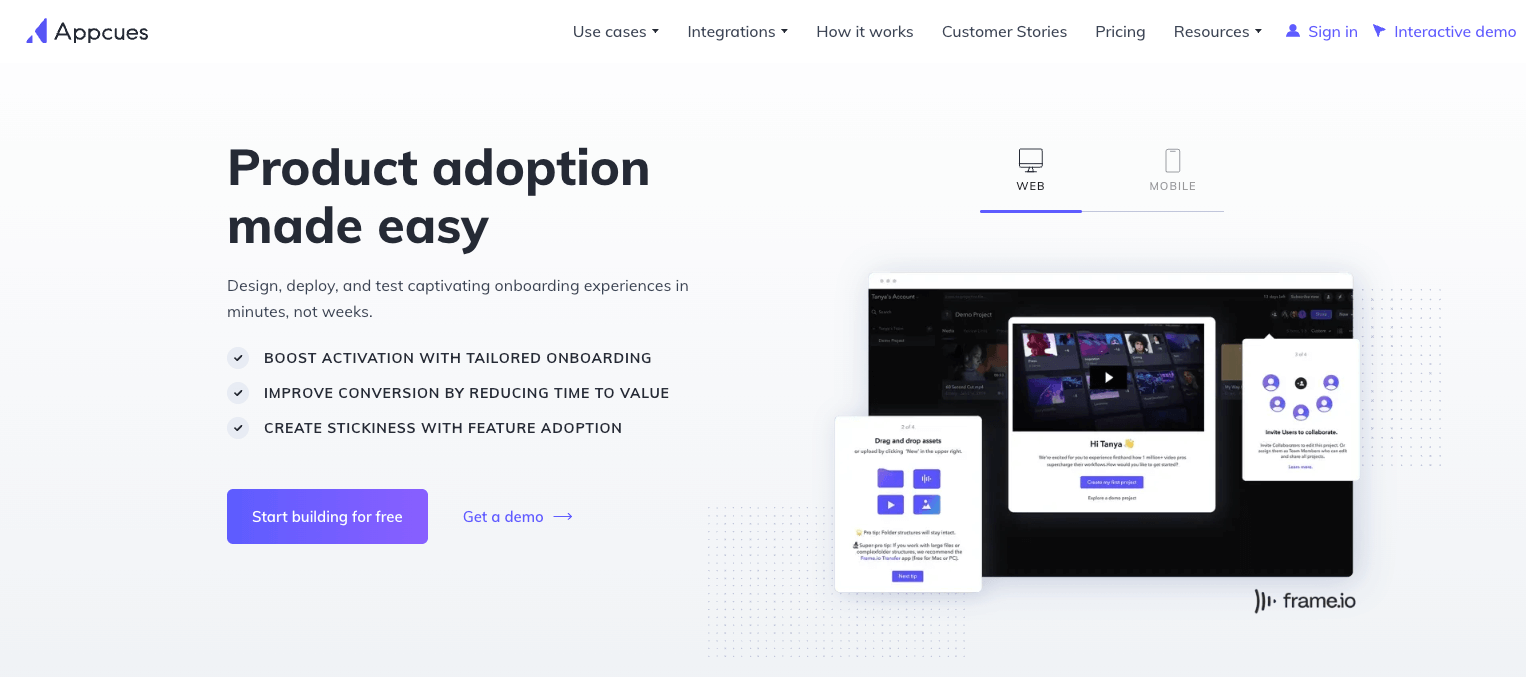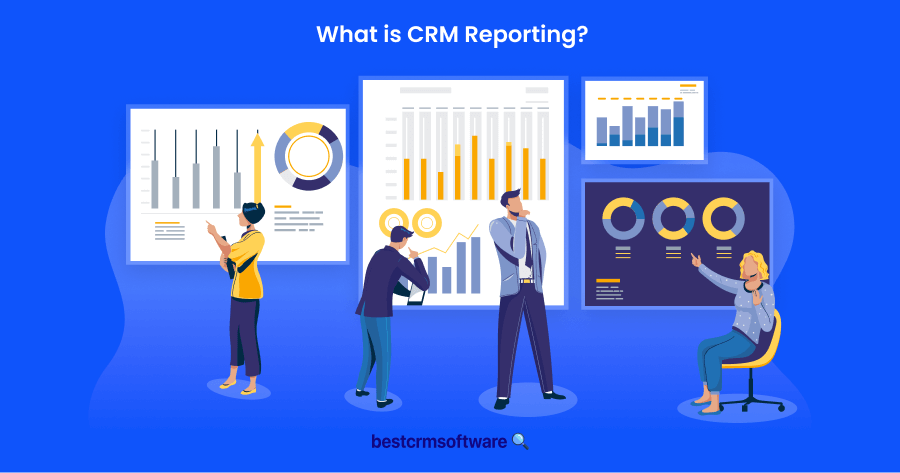
PLG CRM Systems: A Review of Top Product-Led Growth CRM Products
In a Nutshell
The product-led growth market is flooded with so many solutions that it’s difficult to know which option to choose. For most businesses, the goal of adopting PLG software is clear: boost user adoption and improve organic customer acquisition and satisfaction.
As a CRM consultant, I have tested, evaluated, and shortlisted some of the most popular Product-led growth CRM solutions to complement traditional CRM tools. These top picks focus on rapid adoption, organic growth, and better customer relationships:
What is a PLG CRM Software?
Product-led growth (PLG) is a different kind of CRM software that focuses on when a customer first shows up on a website, signs up for a product, makes a purchase, refers other users, and keeps coming back. It’s a customer’s entire lifecycle.

PLG CRM is designed to make the customer’s journey a continuous yet profitable experience that keeps going, unlike a funnel where the experience ends once the customer falls through. With a PLG strategy, instead of ending a relationship with a customer once they convert, you continue the relationship to ensure they stay as long as possible while still bringing others to the business.
PLG Vs. CRM Systems: Key Differences

Product-led growth and customer relationship management are vital tools that support sales, marketing, and customer service within a business. However, they serve distinct purposes and use different approaches to drive business growth and build customer relationships.
PLG is the primary driver of growth and leans more toward product adoption and user experiences.
These tools give users the power to discover and adopt a product on their own terms after discovering what value they derive from it. This acquisition is often made possible through self-service or freemium models.
Product-led growth CRM software puts the product at the front and center of a marketing campaign to drive organic growth and support viral adoption.
In contrast, CRM tools help with customer interactions and relationship management. They assist in tracking customer data, improving communications, streamlining operations, automating workflows, and customizing processes. CRM solutions provide a holistic view of customer journeys, helping personalize interactions and forecast sales.
PLG tools are more user-centric and lean towards product-driven growth, while CRM solutions are all about data-driven insights and relationship building. The former is for businesses dealing with scalable products that depend on viral adoption, while the latter is ideal for companies seeking to onboard and retain more customers with continuous data-driven sales.
In the end, both systems complement each other on various fronts and aspects of business growth. PLG helps accelerate product adoption and encourages organic growth, while CRM solutions support customer relationships and optimize sales processes.
Implementing both solutions can be a powerful strategy for enterprises keen on delivering exceptional customer satisfaction and achieving sustainable growth.
Does a PLG CRM Replace an Existing CRM?
PLG CRM systems don’t necessarily replace existing CRM. The PLG solution provides unique advantages to business growth. They complement CRM platforms, not necessarily replace them, and thus fill the gap where they fail.
PLG CRMs provide user-centric experiences, such as empowering users to sign up, adopt a product, and determine its value independently without the sales team’s input. On the other hand, traditional CRM solutions focus on extensive customization options, deeper customer relationships, and complex marketing processes.
My experience using a PLG tool helped me stay updated on the business product-led operations by delivering notifications that a typical CRM would otherwise not detect. Software engineers developed these tools to work together and complement each other where one fails for increased efficiency.
So, while some companies may succeed with regular CRMs, others require a PLG to advance their operations and up their customer relationship management game, as long as they have the resources and teams for it.

The best PLG CRM Software Tools: My Personal Choices
My Top Pick: Appcues – Best For: Helping Customers Adopt Products Through Personalized Onboarding Flows
Visit Website
Why I Chose Appcues PLG CRM
What I loved most about Appcues PLG CRM is its drag-and-drop builder, which makes learning more accessible for customers. With it, I could collect and manage feedback, conduct A/B testing, and manage user onboarding tours and goals.
Adding these features was pretty straightforward since the drag-and-drop builder eliminates the need for a developer.
Pricing
- Free: Appcues pricing models are available for web applications only. Users may place a special request to access their mobile pricing plans. Fortunately, they don’t require credit cards to sign up for a free trial.
- Essentials Plan: This is the most basic plan, starting at $249 per month for three users with up to five audience segments. It offers email customer support and a 14-day free trial.
- Growth Plan: The growth plan costs $879 per month per 2500 users with ten user licenses. It supports unlimited audience segmentation UI patterns. Provide access to Premium Integrations packages, including Salesforce, Slack, Marketo, and Zendesk. 14-day free trial available.
- Enterprise: Enterprise has all the features and supports unlimited integrations. It provides custom prices on request and comes with a dedicated customer success manager and technical implementation manager. A 14-day free trial is available.
Features
The Appcues Flows feature is especially essential for creating customized user onboarding journeys and welcoming new users. The Checklists feature also acts as a guide to new customers, monitoring their progress as they orient themselves with the platform.
Segmentation and event tracking is all about personalizing customer journeys based on their experiences with the product.
Integrations
Appcues integrates with both native and external platforms, including more than 20 email automation and analytic tools. Its native integrations include Fullstory, LogRocket, and Hotjar, while it also works with big names like Google Analytics, Google Tag Manager, Heap, Hubspot, and Zapier.
Summary of Appcues
It’s at the top of my list if the best PLG CRM solution is Appcues. I rank it highly because it’s the one tool that helped me roll up the highest number of customers at one stage of our marketing efforts. With Appecues, monitoring customer behavior had never been so easy as creating interactive workflows.
With it, I could take note of new customer sign-ups and then provide an efficient self-service onboarding experience. The tool allows marketing teams to manage product promotions, launch referral campaigns, and create announcements within the application.
Pros
- Intuitive UI and UX
- Extensive integrations
- Straightforward setup
- Robust user onboarding platform
- Supports web and mobile apps
Cons
- Expensive PLG CRM
- Limited customization options
- Feedback and survey functionalities are limited

Why I Chose Calixa
Calixa provides real-time insights into customer actions when interacting with products. I could see every purchase they made, emails sent, inquiries made, and challenges experienced.
With this vital real-time information, it was easier to shape the direction of my conversations with them since I had an idea of what they needed. In the end, knowing which leads were more likely to convert and taking the necessary action took less time.
Calixa Pricing
- Free: Freemium, which allows users to access some of its premium features for free. It also offers quotation-based prices and subscriptions. The freemium can accommodate up to 10,000 customers and up to three team members and supports all integrations.
- Starter Plan: The starter plan is available for $199 /Month (annual billing) and supports 50,000 users and five team members. It includes all integrations and support available on the platform.
- Pro Plan: This plan costs $875/month (annual billing) and supports unlimited users, accounts, and ten team members. The package includes all integrations, onboarding, team training, and a shared Slack channel. As an add-on, you can also obtain AI-account scoring.
- Enterprise Plan: The Enterprise plan offers customized prices with unlimited users and accommodates unlimited team members. It supports all integrations included in Calixa and has a dedicated success team.
Calixa Features
Calixa is a feature-packed cloud-hosted PLG CRM software for small businesses. Its primary features include:
- Lead Scoring
- Project Management
- Marketing Automation
- Contact Management
- Quotes (Proposals)
- Customer Support
- List Management
- Product Catalog
- Call Logging
- Referral Tracking
Calixa Integrations
From Calixa’s extensive integration library, I could instantly view all customer data in a single place. The platform works with other robust SaaS apps, reverse ETL platforms, and data warehouses.
Notable examples include Hubspot, Salesforce, Amplitude, Census, Front, Amazon Redshift, Sentry, Mixpanel, Stripe, Zapier, Slack and Zendesk.
Summary of Calixa
Sometimes, it’s difficult to understand customer intentions or behavior when interacting with a product. The Calixa platform helped me understand each customer’s goal based on their activities after signing up for products.
It helped me monitor their journey with precise analytics, and from this data, reaching out and engaging them to understand their needs better was a step in the right direction.
Pros
- Easy to use and set up
- Great for amateur sales teams
- Organized bulk emails
- Excellent onboarding process
- Easy to manage integrations
- Affordable software
Cons
- Limited dashboard customization
- There are some frequent UI bugs
My Third Pick: Pendo — Best for Improving Customer Experience with Product Usage Data
Visit Website
Why I Chose Pendo PLG
From the insights I gained while testing Pendo, I could set in-app messages, guides, and walkthroughs so customers could maximize their product use thanks to its dependable No-code feature.
As a behavioral analytics solution, Pendo extracts and analyzes crucial data to determine what changes need to be made and segment users into different groups.
It also features communication and research tools for sending feedback and conducting surveys and polls to understand where the product is underperforming. It’s a robust platform with even more robust integration functionalities.
Pendo is compatible with Calendly, Hubspot, Optimizely, Figma, and Microsoft Teams. Pendo prices are available upon request and customizable to suit various needs. However, it has a free forever plan with great features.
Pendo Pricing
- Free: Try Pendo’s power for Free. The free version allows up to 500 monthly active users (MAUs) and includes product analytics, in-app guides, Pendo-branded Net Promoter Score (NPS) surveys, and roadmaps; no credit card is required to start.
- Growth: Best for organizations with a single product. This plan accommodates a custom number of MAUs and includes product analytics, in-app guides, unbranded NPS surveys, roadmaps, and cross-app reports. Pricing is customized.
- Portfolio: This product is ideal for organizations working with multiple web and mobile apps. Its features include custom MAUs, product analytics, in-app guides, unbranded NPS surveys, roadmaps, and cross-app reports. Pricing is provided upon request.
Pendo Features
Pendo’s exceptional capabilities are evident in its excellent features, which include:
- Revenue growth
- Product led growth
- In-app support
- Product planning
- User experience
- Feedback collection through NPS surveys
- Product analytics
Integrations
As a robust PLG CRM, Pendo seamlessly compliments the capabilities of other CRM solutions data warehouses, including powerful tools such as:
- HubSpot
- Amazon S3
- Algolia
- BigQuery
- Breadcrumbs
- Drift
- Figma
- Fulcrum
- Gainsight
- Google Cloud Storage
Summary of Pendo
One key element of successful sales and marketing is knowing what customers are looking for and fulfilling their needs. However, knowing what different customers need is not always easy unless you have clear insights and data on customer experience with a specific product.
That’s what Pendo is all about. It’s a program designed to help marketing teams understand which features customers adopt most and which are underutilized. It’s knowing which features of a product are solving the majority of customer problems and which ones are dormant. That’s what Pendo does best.
Pros
- Easy to use, beginner-friendly
- Excellent customer service
- Extensive features
- Value for money
- Multi-platform analytics
- Reliable No-code feature
- Custom themes
- Flexible dashboard
Cons
- Key features are locked inside the pro plans
- Experiences data lags
The Bottom Line
PLG CRMs are there to do what CRMs can’t do: prolong the customer lifecycle as much as possible, even after they have dropped down the bottom of the sales funnel. These tools are designed to make customer relationships more solid and long-lasting with post-lead sales and referrals for increased revenue growth.
PLGs are not meant to replace traditional CRM tools since each serves a different purpose but has many functional similarities. Instead, PLG CRMs are there to enable teams perform out-of-the-box analysis without relying on a data team.
The information gleaned from these analytics can be used to improve operations within the PLG CRM or transferred to other powerful CRM platforms, such as HubSpot or Salesforce, for more impactful execution.
Check out our other blogs too! Our CRM experts publish helpful content daily, covering a wide range of topics from how-to guides to articles on the best No-Code CRM solutions.








